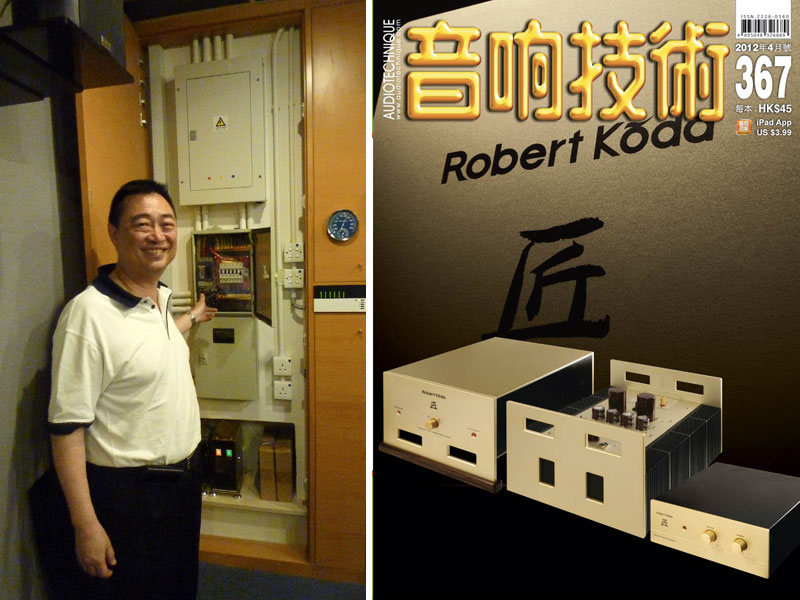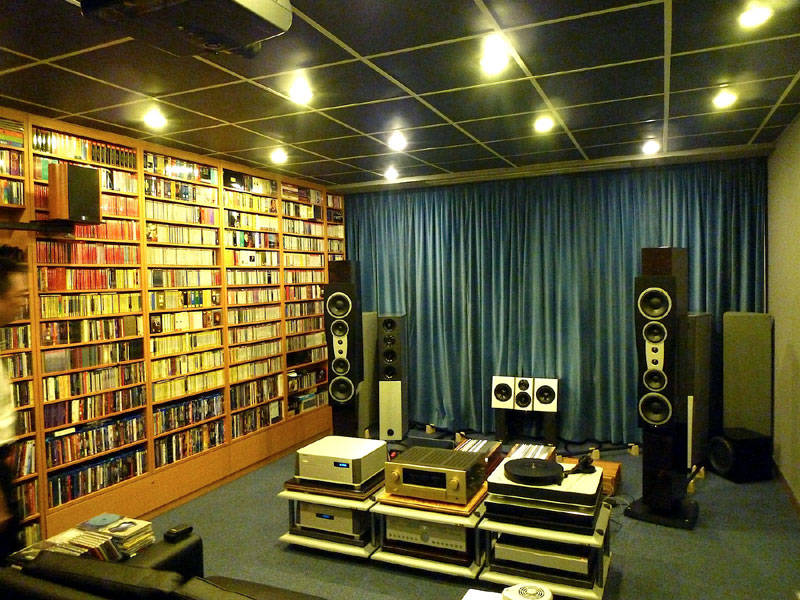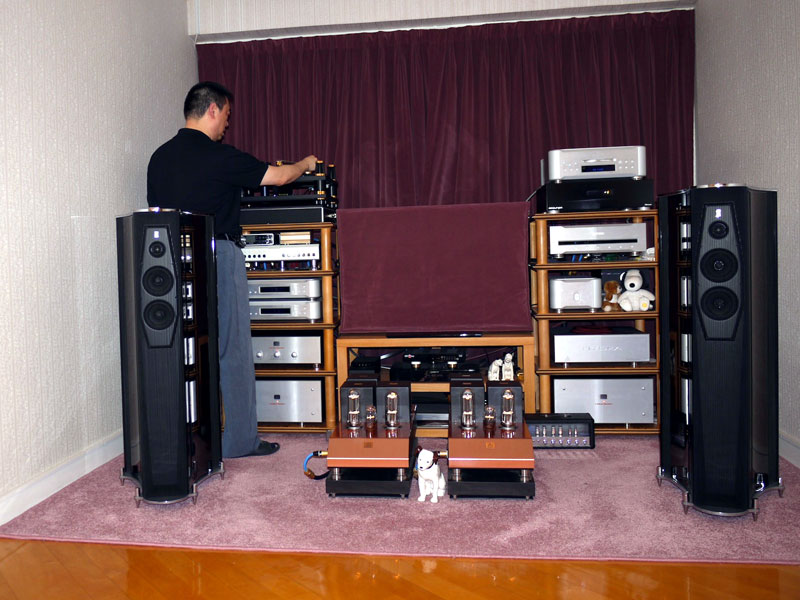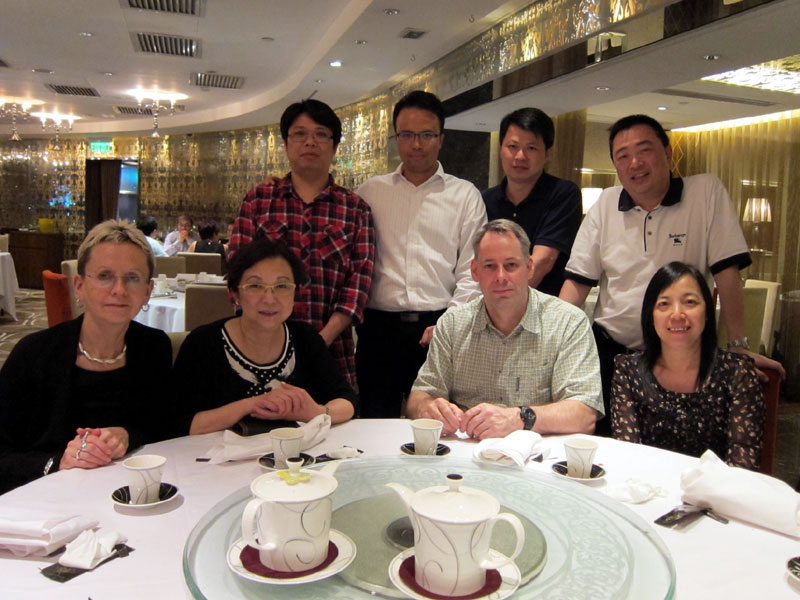Audio
Technique: A Magazine with a Serious(-ly Good) Attitude
emember the days when Stereophile used to land on your mat with a serious thud? When its page count and paper quality didn’t remind you of a Marvel comic? Well, think about doubling the thickness of the thickest Stereophile you ever saw and adding a thick card cover, seriously glossy page stock, in-house photography and superior graphics and design and you are getting somewhere close to Hong Kong’s leading high-end magazine, Audio Technique. With twelve issues a year as well as organizing the Hong Kong High End Audio Visual Show, 190 pages of advertising and 150,000 words an issue, this is a serious business, whichever way you look at it. Operated by a staff of around ten from a compact suite of offices in North Point, Hong Kong side, and with a writing roster of another 20 contributors, the sheer volume of work keeps editor Lincoln Cheng and publisher Rebecca Chin fully occupied.
The man and the magazine. But what really impressed me was the magazine’s own listening room, attached to the side of the office suite. Before I go into detail, just stop to consider the cost of real estate on Hong Kong island; okay, so North Point isn’t exactly up there with Central as regards property prices, but that only means it’s several times the cost of office space in Downtown Manhattan. This room is a serious financial commitment before you even start to consider the setup and installation costs.
The space, 14’ by 23’, is partitioned off from the office suite, a double door insulating for sound. Front and rear walls are structural concrete, the side walls being stud construction, but skinned with specially selected boards that are also used to construct sound booths. The front wall carries a screen hidden behind full-depth curtains, with three RPG diffusers positioned behind the listening seats and a couple of bass traps behind the speakers.
So much for the basic construction and acoustic treatment. What really sets this system apart is the care that’s gone into the power-supply arrangements and the equipment setup. Let’s start at the beginning (a very good place to start) with the electrical supply itself. This is a commercial three-phase supply that in this case is used to run the office, audio and video systems separately, each on a dedicated supply. The fuse boxes/relays and other hardware are all carefully selected, with massive grounding wires and gold-plated busses. The audio supply employs a main master circuit breaker (MCB) from Merlin Gerin in France, with six further, separate MCBs from Siemens in Germany. These are modified with polished metal parts and 24K gold plating. The first of the Siemens MCBs is connected to two isolation transformers and then to a Shunyata Hydra Triton. It is used for digital equipment only. The other MCBs are fed directly to high-quality wall sockets for analog electronics or sources. Main sources comprised (this is a review system so they constantly change) the Wadia 9-series four-box CD replay system, a Feickert turntable fitted with a 12” SME V tonearm and Ortofon Windfeld cartridge. These fed a Boulder 2010 line stage and a pair of D’Agostino Momentum monoblocks; speakers were Dynaudio C4 Signatures. All in all, that’s a pretty sparkly lineup of equipment, but the thing that really made an impression was the care that went into supporting and wiring the system, the "infrastructure" that I spend so much time banging on about. As well as the trio of TAOC two-tier racks, every piece of the system was separately supported on and coupled to a platform from Venture, SRA or Symposium. All signal and speaker cabling was Siltech, the latter elevated -- naturally. But in addition a separate set of chassis grounds (also all Siltech) were connected to an EntreQ TellUs ground block, providing a clean earth in what must surely be one of the most contaminated ground environments on the planet. Certainly, disconnecting even a single chassis ground had an instant impact on this most revealing of systems. It was also reassuring to witness an almost religious devotion to Furutech’s Demag and Destat devices, both of which I also rely on at home. Having all too often witnessed review equipment shoehorned into existing setups on an almost ad hoc basis, such care and attention to detail are rare, refreshing and revealing. Indeed, "revealing" is the word. The Boulder and Dynaudio products are amongst the most clinically detailed and exact I’ve ever used, while the D’Agostino amps aren’t exactly lacking control. That makes this one of the most precisely focused and defined systems I’ve heard, especially fed from the top-of-the-range Wadia rig. It made for fascinating comparisons (and discussions) when it came to different issues of the same recording. With several of the Audio Technique reviewers on hand, there was plenty of lively entertainment to be had when it came to the debating the merits of the different discs. In fact, one of the most refreshing things about the time spent with the Audio Technique crew was the open enthusiasm and interest they display for all aspects of audio and music. Contrasting approaches to the assessment and description of sound were both fascinating and thought-provoking -- a trend that was only to continue. Bringing it home
sked to comment on the office setup, I suggested it was "a little too much head, not enough heart" for my own musical tastes. "Ah, wait until you hear my home system," responded a smiling Lincoln -- an opportunity that arose a couple of nights later. Now, remember that this is Hong Kong and property prices rise as high and as frequently as the tower blocks that dominate the skyline. If you expect large apartments and spacious listening rooms, you are going to be disappointed. Even so, I wasn’t quite prepared for the sheer number of boxes crammed into one end of Lincoln’s lounge. Of course, a four-box digital front-end, three boxes for the preamp and another two for the phono stage are always going to stack up. Throw in a pair of monoblocks, a Blu-ray player and a flat-screen and you bring new meaning to the term "wall of sound." Having already seen (and heard) the sort of kit that gets used in the office system, I was expecting something a little special and I wasn’t disappointed. Digital replay was from an Esoteric P-01vU/D-01vU combination, complete with external master clock, for a grand total of five boxes. An SME 3012 fitted with a Thales Simplicity tonearm and Air-Tight PC-1 cartridge fed a My Sonic Labs step-up transformer and a Boulder 2008 phono stage. The line stage was from Audio Note (the later, UK-based company rather than the Japanese original founded by Kondo-san), an M10 Signature with dual external power supplies, in turn feeding a pair of Gaku-On parallel 211 single-ended triode amps. The main system was supported on Venture racks and the disc spinners stood on Accurion active isolation units. Cabling was more of a mix-and-match affair than the office system, but the Shunyata/Siltech axis was still dominant. The main system runs from a Shunyata Hydra Triton, with separate Hydras for each power amp. The majority of power cords are Shunyata Zi-Tron Anacondas, but Audio Note SOGONs are used for the M10 Signature and SME power supply, the new Crystal Cable Absolute Dreams being assessed at present, currently hooked up to the Esoteric transport and power amps -- an interesting comment on power priorities within the system. Signal and speaker cables are Siltech Empress/Emperor Double Crown throughout, apart from a pair of Tara Labs AES/EBU leads from the Esoteric transport to its dual DACs. Final piece in the jigsaw was the Tripoint Audio Troy grounding terminal, an even more exotic alternative to the Entreq at the office. And speakers? What speakers would you hang on the end of that chain? In this case it’s Franco Serblin’s (post Sonus Faber) Ktema floorstanders.
That’s quite a laundry list, but the full version, including all the various alternative cartridges, can be seen in the sidebar. Yet, despite the apparent complexity of the setup, the sound was sweet, open, dimensional and detailed, yet with surprising authority and a natural sense of musical integrity and integration. A parade of vocal and smaller-scale recordings demonstrated that, just as promised, here was a system that was all heart, yet irrespective of whether we played CD, SACD or LP, it was astonishingly immediate and communicative. But the best and most remarkable I’ve kept for last. Glass CD -- a technology in which the CD disc is literally made of glass as opposed to polycarbonate -- has been largely ignored in the UK and US. That’s partly down to the limited availability of titles, partly down to cost -- but I’ll get to that later. Produced in tiny numbers these discs are almost unknown outside Japan. Each disc looks just like a normal CD, the only difference being the packaging. Stereo Sound magazine sponsored a limited release of 100 pieces of the Jennifer Warnes album, The Hunter. This was the first disc we heard, and very impressively natural and detailed it was too -- definitely in another league to everything else we’d played. But the really astonishing experience came next. Karajan’s 1962 Beethoven cycle is widely regarded as his best (the 6th Symphony aside). With a devilish flourish that should have warned me of what to expect, Lincoln produced a Glass CD version of the 9th Symphony, proceeding to play the familiar climax. Okay, confronted with a classical orchestra and chorus running full tilt, the amps were starting to struggle, but at anything less than maximum wick, the sound was simply astonishing. Never -- and I do mean never -- have I heard a disc that captures so precisely yet naturally the sensation of a live orchestral performance. It’s about the presence and immediacy, the sheer uncluttered clarity and intelligibility of the music, the sense of limitless bandwidth and absolute authority at both extremes. All of which might seem strange given that we’re talking Red Book replay via single-ended triodes, but this is not to do with the system doing the playing. It’s to do with fundamentally better source material. I don’t think it would have mattered what system you played that disc on -- you couldn’t have missed just how spectacularly musical it is. Now Google Glass CD and you’ll discover that they are almost invisible. Lincoln possesses around 17 titles, and there are others out there, but I’d be surprised if the total exceeds 50 or so. The second issue is the price. These things are not cheap, and by the time you take licensing fees and the limited production numbers into account, you just know that these are going to be expensive. How expensive? The Karajan disc was listed (when you could still get it) at 200,000 Yen. The best price I could find was 170,000, which translates to a cool £1360 -- or around $2000! For one disc! The Jennifer Warnes was around half that, but even that makes it eye-wateringly expensive. Too expensive to be relevant? Well, yes and no. On the one hand, anybody who has perused the prices of a decent vintage Mouton-Rothschild in a Michelin-starred restaurant will find those numbers (disturbingly) familiar -- and that’s a one-time, one-play experience. On the other, listening to the Karajan disc in particular -- its unobstructed purity and easy flow, the total absence of grain -- makes you realize that the CD format is inherently better (at least at a theoretical level) than many of us give it credit for. What Glass CD demonstrates categorically is just how many of CD’s shortcomings lie in the physical constraints of the disc and the materials it’s made of. Mind you, I’ve heard that song somewhere before, probably in the late '70s whilst holding a floppy disc -- I mean, LP.
Meeting the Audio Technique team was an
entertaining, enjoyable and at times ear-popping experience. It was also tremendously
encouraging to find such enthusiasm and to enjoy such astonishing experiences after so
long resisting the downbeat cynicism of so much of the audio industry in the UK and US.
Only an ostrich would deny that the center of audio gravity is shifting East. On this
showing it’s easy to understand why. |




